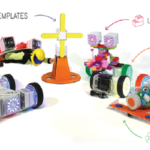

Without innovation, this world would be a pretty boring place. A lot of people look at 3D printing as an invention which has the potential to change the way we manufacture, self-fabricate, and perhaps even bring the third-world up to par with developed nations. However, we wouldn’t be here today without the innovative minds that have been able to come up with ideas for the mechanisms which drive the many different types of 3D printers that currently exist. If it wasn’t for inventions like the heated extruder, the idea for the FFF 3D printer would have never gotten off of the ground. If it wasn’t for the direct light processing projectors that have been created, there wouldn’t exist Stereolithographic DLP 3D printers. As the days, weeks, months, and decades go by, there will be creative minds popping up with ideas on how we can create new mechanisms to drive the 3D printing process. With these ideas, will come the birth of new 3D printable materials, faster speeds, and better efficiency.
Recently at Startup Weekend in Lansing, Michigan, a team called Maizena 3D decided to showcase some of their unique 3D printing technology. The team, coached by Joe Carr, a 3DP consultant and startup adviser in Lansing, showcased a new type of 3D printer extruder that doesn’t work like the typical heated extrusion systems you see in today’s FFF based 3D printers. Instead it runs off of something as simple as air. That’s right, it is completely air powered and capable of extruding a corn starch/water mixture, via a traditional 3D printer nozzle.
“Tom Deits pitched an idea for using off the shelf corn starch and water as a 3D printing material,” Joe Carr tells 3DPrint.com. “I brought in a Printrbot LC and a B3 Innovations Pico hotend for the team to base the project on. They initially used a heavily modified grease gun to create pressure to force the solution through the hotend. After a few tests they adapted the grease gun to an air powered source but battled with leaks. So the second night they created a new system to deliver the material with much better results. The extrusion behaved surprisingly close to traditional materials. We are very excited for what we achieved in less than 54 hours.”
The team went with corn starch because it is one of those materials that is easy to find, while also being very affordable. “You can pick up a pound of it for less than $1.50 at almost any grocery store,” Carr explained to us. “It’s a very eco friendly material, dissolves in water and we felt it could serve for some very unique products. One example is custom packaging for products or items. Imagine a museum that needs to store or ship a marble bust. They can 3D scan it and print out a custom shell to protect it.”

So far, Carrs team has found that using a 0.6mm nozzle with air pressure of 100 psi at approximately 90 degrees worked best in extruding the corn starch, in a similar manner to that of traditional 3D printers. Next, they want to explore the possibilities of printing expanded foam, using corn starch as well. This could allow for the 3D printing of very large objects, very quickly, as well as the creation of noise dampening and insulating products. They will also be exploring the use of other materials, and ways in which they can deliver this liquid-based material through traditional FFF 3D printers.
Carr is no newcomer to the 3D printing scene. He has helped start one of the very first retail shops at The 3D Printer Experience in Chicago, as well as launch a 3D printing project management platform in Detroit, called Manulith. He continues to work within the space, and is always looking for new projects to be a part of.
What do you think about this unique extrusion system? Does it have potential in allowing for the 3D printing of more affordable, as well as different materials? Discuss in the air powered 3D printing forum thread on 3DPB.com. Check out some of the video demonstrations below.
If you're looking to get architectural 3D animation in the USA, our service provides an exceptional way to bring your architectural concepts to life through dynamic, immersive visuals. Through our platform, you can easily request high-quality 3D animations that showcase your designs in motion, offering a detailed view of your project from multiple angles and perspectives. Whether it's for a real estate development, a commercial building, or an urban planning project, our expert team ensures that every detail is captured in a visually compelling animation.
Through our website, you can seamlessly get architectural 3D animation tailored to your project’s specific needs. With our help, you can offer potential clients or investors an engaging experience that goes beyond static images. By integrating CGI animations with real-world settings, lighting, and textures, our team creates a lifelike experience that allows your audience to interact with your project as though it were already built. This service is perfect for presenting complex designs in a clear, visually attractive way that stands out in the competitive architectural market.




